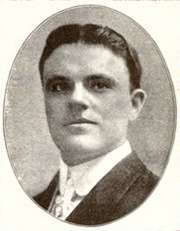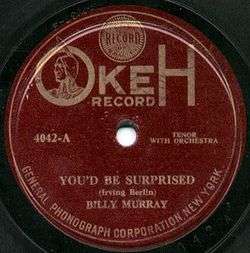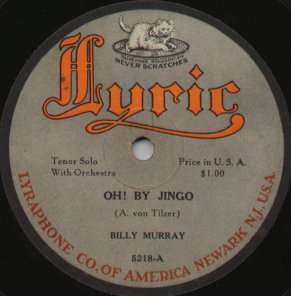Billy Murray (singer)
William Thomas Murray (May 25, 1877 – August 17, 1954) was one of the most popular singers in the United States in the early 20th century.[1] While he received star billing in vaudeville, he was best known for his prolific work in the recording studio, making records for almost every record label of the era.
Billy Murray | |
|---|---|
 Murray in May 1911 | |
| Background information | |
| Birth name | William Thomas Murray |
| Born | May 25, 1877 Philadelphia, Pennsylvania, United States |
| Origin | New York City |
| Died | August 17, 1954 (aged 77) Jones Beach, New York, United States |
| Genres | Pop |
| Occupation(s) | Singer |
| Instruments | Vocals |
| Years active | 1897–1944 |
| Labels | Edison, OkeH, many others |
Life and career
Billy Murray was born in Philadelphia, Pennsylvania to Patrick and Julia (Kelleher) Murray, immigrants from County Kerry, Ireland.[2][3] His parents moved to Denver, Colorado in 1882, where he grew up. He became fascinated with the theater and joined a traveling vaudeville troupe in 1893. He also performed in minstrel shows early in his career. In 1897 Murray made his first recordings for Peter Bacigalupi, the owner of a phonograph company in San Francisco. As of 2010 none of Murray's cylinder records with Bacigalupi are known to have survived.[3] In 1903, he started recording regularly in the New York City and New Jersey area, where major record companies in the U.S. as well as the Tin Pan Alley music industry were concentrated.
In 1906, he recorded the first of his popular duets with Ada Jones. He also performed with Aileen Stanley, the Haydn Quartet, the American Quartet (also known as the Premier Quartet), and Elsie Baker; as well as performed solo work.
Nicknamed "The Denver Nightingale", Murray had a strong tenor voice with excellent enunciation and a conversational delivery compared with bel canto singers of the era. On comic songs, he often deliberately sang slightly flat, which he felt helped the comic effect. Although he often performed romantic numbers and ballads which sold well, his comedy and novelty song recordings continue to be popular with later generations of record collectors.
Murray was a devoted baseball fan, and he is said to have played with the New York Highlanders (Yankees) in exhibition games. He also supposedly sometimes called in sick to recording sessions in order to go to the ballpark. Murray recorded "Tessie, You Are the Only, Only, Only", which became the unofficial theme of the 1903 World Series, when the words were changed from "Tessie, you know I love you madly" to "Honus, why do you hit so badly?"
Murray's popularity faded as public taste changed and recording technology advanced; the rise of the electric microphone in the mid-1920s coincided with the era of the crooners. His "hammering" style, as he called it, essentially yelling the song into an acoustic recording horn, did not work in the electrical era, and he had to learn to soften his voice.
Though his singing style was less in demand, he continued to find recording work. By the late 1920s and early 1930s, the music from his early days was considered nostalgic, and Murray was in demand again. He did voices for animated cartoons, especially the popular "follow the bouncing ball" sing-along cartoons and the Fleischer Studios character Bimbo.[4] He also did radio work.[5] In 1929, Murray and Walter Scanlon provided the voices for the Fleischer short animation film Finding His Voice, produced by Western Electric.
Murray made his last recordings for Beacon Records on February 11, 1943 with Jewish dialect comedian Monroe Silver. He retired the next year to Freeport, Long Island, New York because of heart problems.
Variety estimated he made between 6,000 to 10,000 recordings in 45 years under a range of different pseudonyms, selling up to 300 million records, a record at the time.[6]
He died at nearby Jones Beach of a heart attack in 1954 at the age of 77. Murray had married three times; the first two marriages ended in divorce. He was survived by his third wife, Madeleine, and is buried in the Cemetery of the Holy Rood in Westbury, New York.[3]
In popular culture
Decades later, "You're a Grand Old Rag", and "Shine On, Harvest Moon", two of his songs would be heard in BioShock Infinite, the former being heard faintly in one of the reveal trailers, and the latter being heard in The Fellow Traveller Pub.
His single "Stumbling" was used in the 2016 horror game Layers of Fear.[7]
On May 4th, 2020, musician John Mayer covered Murray's "Just As We Used to Do" with his dummy Cecil as part of his Sunday night IGTV show 'Current Mood'.[8]
Selected song discography


- "Ain't It Funny What a Difference Just a Few Hours Make"
- "Alexander's Ragtime Band"
- "Always Leave Them Laughing When You Say Goodbye"
- "Any Little Girl, That's a Nice Little Girl, is the Right Little Girl For Me"
- "At the Moving Picture Ball"
- "Be My Little Baby Bumble Bee" with Ada Jones
- "Because I'm Married Now"
- "Blue Feather" with Ada Jones
- "Bon Bon Buddy"
- "Charley, My Boy"
- "Cheyenne"
- "Clap Hands! Here Comes Charley!"
- "College Life"
- "Come Josephine in My Flying Machine" with Ada Jones
- "Cordelia Malone"
- "Cuddle up a Little Closer, Lovey Mine" with Ada Jones
- "Daddy, Come Home"
- "Dear Sing Sing"
- "Dixie" with Frank Stanley, Ada Jones
- "Don't Bring Lulu"
- "Everybody Works But Father"
- "Forty-five Minutes from Broadway"
- "Gasoline Gus"
- "Give My Regards to Broadway"
- "Harrigan"
- "He'd Have to Get Under — Get Out and Get Under (to Fix Up His Automobile)"
- "He Goes to Church on Sunday"
- "He May Be Old, But He's Got Young Ideas"
- "Hello, Hawaii, How Are You?"
- "I'm Afraid to Come Home in the Dark"
- "In My Merry Oldsmobile"
- "In the Good Old Summer Time"
- "In the Land of the Buffalo"
- "In the Shade of the Old Apple Tree"
- "It's a Long Way to Tipperary"
- "It's the Same Old Shillelagh"
- "It Takes the Irish to Beat the Dutch"
- "I've Been Floating Down the Old Green River"
- "I've Got My Captain Working for Me Now"
- "I've Got Rings On My Fingers"
- "I Want to Go Back to Michigan"
- "I Wonder Who's Kissing Her Now"
- "K-K-K-Katy"
- "Oh! By Jingo"
- "Oh, You Beautiful Doll"
- "On Moonlight Bay"
- "On the 5:15"
- "On the Old Fall River Line"[9] from 1913
- "Over There"
- "Play a Simple Melody with Elsie Baker
- "Pretty Baby"
- "Pride of the Prairie"
- "School Days" with Ada Jones
- "Shine On, Harvest Moon" with Ada Jones
- "Some Sunday Morning" with Ada Jones
- "Tessie"
- "Tipperary"
- "Under the Anheuser Bush"
- "The Worst Is Yet to Come"
- "The Yankee Doodle Boy"
- "You'd Be Surprised"
- "The Grand Old Rag (Flag)"
See also
References
- Ruhlmann, William. "Billy Murray". Allmusic. Retrieved October 14, 2011.
- US Census, 1880, 24th Ward, District 21, Philadelphia, PA
- "Billy Murray: A Biography". The Official Website of Billy Murray (1877-1954). Phonostalgia. Retrieved October 14, 2011.
- "The Walter Lantz Cartune Encyclopedia: 1930". The Walter Lantz Cartune Encyclopedia. Archived from the original on May 14, 2011. Retrieved April 24, 2011.
- Barna, Ryan. "BILLY MURRAY'S RADIO PROGRAMS: Walter Scanlon and Marcella Shields". The Official Website of Billy Murray (1877-1954). Phonostalgia. Retrieved October 14, 2011.
- Walsh, Jim (January 9, 1957). "Bing Crosby's 130,000,000 Disk Sales Makes Him Champ of Modern Era". Variety. p. 239. Retrieved June 12, 2019 – via Archive.org.
- "BILLY MURRAY DISCOGRAPHY: Victor Records (1903-1913)". THE OFFICIAL WEBSITE OF BILLY MURRAY (1877-1954). Archived from the original on April 6, 2012. Retrieved October 7, 2011.
External links
| Wikimedia Commons has media related to Billy Murray. |
- The Official Website of Billy Murray: The Legendary Denver Nightingale
- The Billy Murray Pages: Articles, Photographs and Discographies
- Biography with sound samples
- Billy Murray recording of "The Grand Old Rag" (later retitled "The Grand Old Flag")
- Billy Murray recording of "He'd Have to Get Out and Get Under to Fix up His Automobile"
- Billy Murray cylinder recordings, from the UCSB Cylinder Audio Archive at the University of California, Santa Barbara Library.
- Discography of Billy Murray on Victor Records from the Encyclopedic Discography of Victor Recordings (EDVR)
- In search of Billy Murray - interview with Sam Herman, Peter Dilg & Lew Green Jr. on Thomas Edison's Attic radio program, WFMU, May 4, 2004.
- List of best-selling recordings with chart entries
- Billy Murray, Anthology: The Denver Nightingale (Archeophone Records 5501)
- Works by Billy Murray at Project Gutenberg
- Works by or about Billy Murray at Internet Archive
- Billy Murray on IMDb
- Billy Murray at Find a Grave